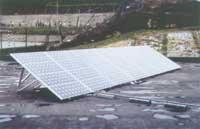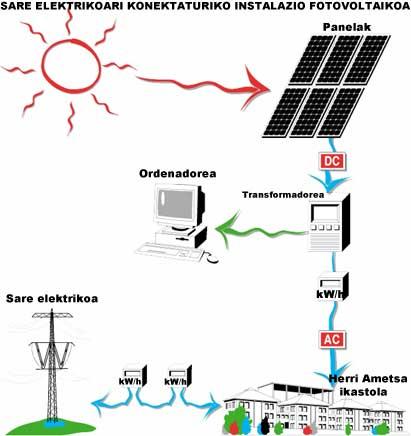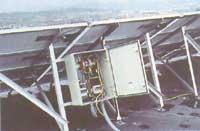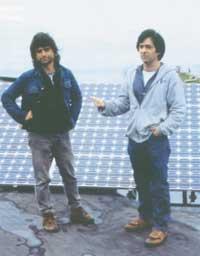Alternative energies at the service of education
Ikastola Herri Ametsa wanted to take another step in education. Considering the opportunity offered by the place where the ikastola is located, and anticipating the additional income that could be obtained with the organization of the Kilometroak of 1995, it was proposed to give a pioneering vision of education through the violation of alternative energies. Say and do.

With this intention it was intended to fulfill two objectives, one of them being transgressor and, at least in part, self-feeding the ikastola itself with electric energy. But how to do it if you don't have experts? Fortunately, in Euskal Herria there are groups working on alternative energies. And before starting the tour they went to one of them, the Ekain Taldea of Errenteria.
We also did the same when we met the installation and decided to do the article. And the members of the Ekain Group explained to us that it was a huge job to carry out the project. First, you had to select the type of installation. Considering the environment, one could think that the alternative could be wind energy, and so the Herri Ametsa initially proposed. However, once the data were collected, after checking the wind speed in it, this route was abandoned and the second possibility of obtaining photovoltaic energy from solar panels was studied.
Based on the data provided by the members of the Ekain Group, those of Albasolar carried out the design and the friends of Errenteria were responsible for the assembly and monitoring of the operation.
It is one of the cleanest energy production systems, but also one of the most expensive today. The installation carried out in the ikastola Herri Ametsa has cost more than seven million, of which 26% has been paid by the EVE of the Basque Government, while the rest has been in charge of the ikastola.

Operational
The interlocutors of the Ekain Group told us that this alternative route of electric generation has a very simple structure (see diagram above). The main components are the panels and the transformer connected to the computer and the power grid. The essential element is the sun.
The mission of the 56 roof panels is to capture solar radiation and transform this energy into electricity. Since the electric current generated is continuous, the transformer is responsible for transforming this current into alternates. The transformer also assumes the synchronization function of the two electrical circuits, coupling at all times the electricity generated by both the electrical grid and the panels. The computer connected to the transformer receives information every four minutes: voltage, current and power in the solar panels, current and voltage in the network. This data collection allows the comparison at any time of the productions of the different days and the extraction of data of the last two years.
Economic profitability?

Both the members of the Ekain Group and the director of the ikastola told us from the beginning that the new structure would not fully meet their needs and that of course it would not be profitable. But the pedagogical objective of providing one of the four buildings with a new educational facility was prioritized so as not to waste the electricity obtained.
The interlocutors explained that with these fifty-six panels the light force needed by a building is achieved. The electricity not consumed is transferred for use to the Iberdrola electricity grid, since the system does not have accumulators. And if it happens backwards, that is, if the ikastola needs to consume more energy than normal, it takes electricity from the grid and pays it.
Educational objective
As mentioned above, the aspirations of the ikastola Herri Ametsa are far from achieving economic profitability. They have recognized that the main objective of the use of alternative energy is that of didactics. Its objective is to make known, in addition to seeking practicality, the sun among other sources of energy. For students to become familiar with data collection, observation and graphic reading, it is used as a new knowledge framework in other subjects.

Since the Sun is a natural source of energy, this project can also serve to foster environmental responsibility, and this is what he stressed when we asked the ikastola director about his intentions.
The future of alternative energies
Although in common structures photovoltaic installations are, to this day, hardly profitable economically, one cannot forget this alternative path (nor the rest). In Euskal Herria some tests have been carried out and economic profitability has been obtained. For example, the panels have been used in areas where the electricity grid does not reach, such as Aralar and Urbia pastoral shacks, electric signage of several highways, etc. In these cases, the installation of an autonomous structure is cheaper than the transport of electricity to it.
For the Ekain Group, which has been our interlocutor, the new challenge is to start using this alternative energy in towns and cities, and analyzing the possible combinations of all existing alternatives for this, we will have to create autonomous elements. In the regions that are less than ours, they already take into account this possibility.
Photovoltaic installation in figuresIn total there are fifty-six panels that absorb the rays of the sun. They are distributed in two groups of twenty-eight, each of them attached to the floor of the roof of the fronton, with a inclination of 30 °. In total, the panels occupy an area of 34 m 2. The plant has a power of 4.2 kW. But obtaining this power is practically impossible, since all panels should provide the maximum performance, situation that only occurs in the laboratory. The panels provide annual production of 6,200 kW/h. The fact that the natural source of energy is “endless” and clean has its advantages, although currently the installation is expensive. The Ikastola Herri Ametsa initiative will produce 3,700 kg of CO 2, 8,300 g of OS 2 and 10,500 g of NOx per year. |
Buletina
Bidali zure helbide elektronikoa eta jaso asteroko buletina zure sarrera-ontzian











